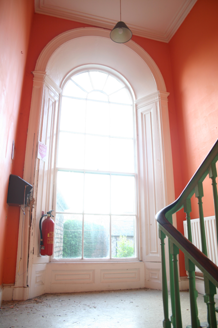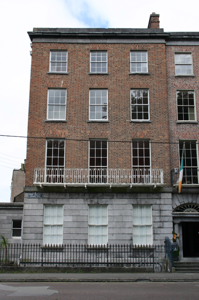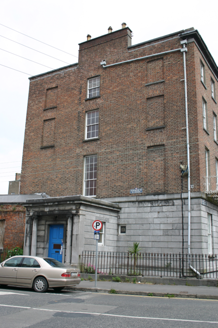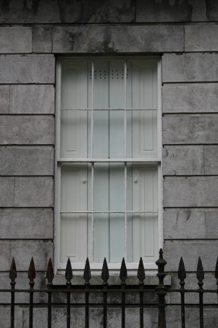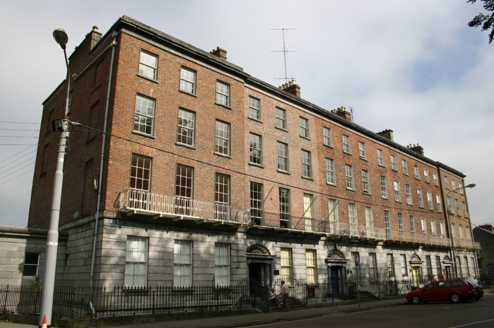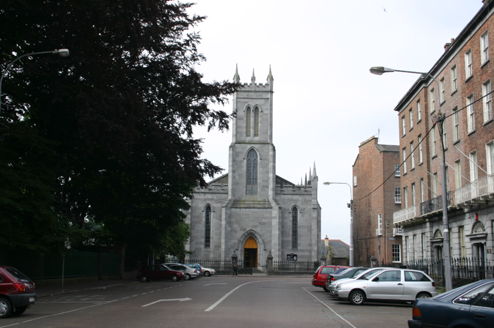Survey Data
Reg No
21517182
Rating
National
Categories of Special Interest
Architectural, Artistic, Historical
Original Use
House
In Use As
Unknown
Date
1835 - 1840
Coordinates
157422, 156472
Date Recorded
10/08/2005
Date Updated
--/--/--
Description
Corner-sited end-of-terrace three-bay four-storey over basement house, built between 1835-38, terminating the southern end of a terrace which is collectively referred to as the Tontine Building. The terrace forms a grand composition of six houses, each of which is unified by a number of architectural features including a rusticated limestone ashlar ground floor elevation, a wrought-iron balcony, fenestration alignment and limestone ashlar parapet entablature. No. 1 (and No. 6 terminating the northern end), is further distinguished by an entrance porch to the three-bay four-storey over-basement south-facing side elevation. Roof structure concealed behind a parapet wall to each elevation. A red brick chimneystack with octagonal clay pots rises flush with the side elevation and another rises from the party wall with No. 2, which has standard clay pots or recent origins. uPVC rainwater goods. Tooled limestone ashlar basement elevation terminating at ground floor level with a smooth limestone ashlar plinth course above which a channel rusticated limestone ashlar elevation articulates the ground floor; first, second and third floor elevations are faced in red brick laid in Flemish bond with cement repointing. Limestone ashlar parapet entablature. Square-headed window openings, red brick flat arches, patent rendered reveals, limestone sills, and six-over-six timber sash windows to ground second and third floor level, nine-over-six to first floor level. Blind window openings to south-facing side elevation. Round-arched stair hall window openings to rear elevation with red brick arches and six-over-six and nine over six timber sash windows with fanlighted upper sashes. Limestone ashlar door porch comprising Doric piers and full Ionic columns rising from a shared base supporting a parapet entablature. Orders flank a recessed channel rusticated elevation with centrally-placed square-headed door opening, articulated by limestone ashlar architrave with block ends terminating threshold step; reproduction raised and fielded panelled timber door leaf. Door arrived at by a flight of limestone steps, with cast-iron bootscrapers flanking rear site. Front site enclosed from pavement by limestone plinth wall supporting wrought-iron railings with spear-head finials. Original square-plan coal hole cover set in limestone flag with Neo-classical radiating ovals to four corners and the letters PS [Pery Square] to centre. Attached to the porch to the west along Barrington Street is a multiple-bay two-storey red brick building, of later date, but of great contextual importance elucidating the evolution of the site. Red brick wall divides rear site from No. 2 with red brick coping. The Georgian planned townhouse interior retains many intact features including staircase, shutter boxes and shutters, and fine cast decorative plasterwork.
Appraisal
This former house is in very good condition apart from the loss of its original front door leaf. The terrace was conceived as a grand composition of six houses unified by every architectural device within a sober and restrained late Georgian idiom. The terrace was constructed as a speculative development by the Pery Square Tontine Company which had as its members in 1836: Alderman Henry Watson (Chair), Captain H.M. Ryves, Thomas P. Vokes, C.M.P. Alderman D.F.G. Mahony, Wm. Piercy, Edward Homan, Henry Owens, James Pain, Piens Creagh, Mat. And Dan. Barrington, Esqrs., and Hon. E.S. Pery. The architect James Pain supervised the construction of the terrace and may well have been responsible for the design. The contractor was Pierse Creagh, Ennis. By 1838, the houses forming this terrace were let to tenants. Both as a terrace, and given its context, the Tontine Building is one of the finest terraces in Limerick City and indeed in Ireland, outside of Dublin.
